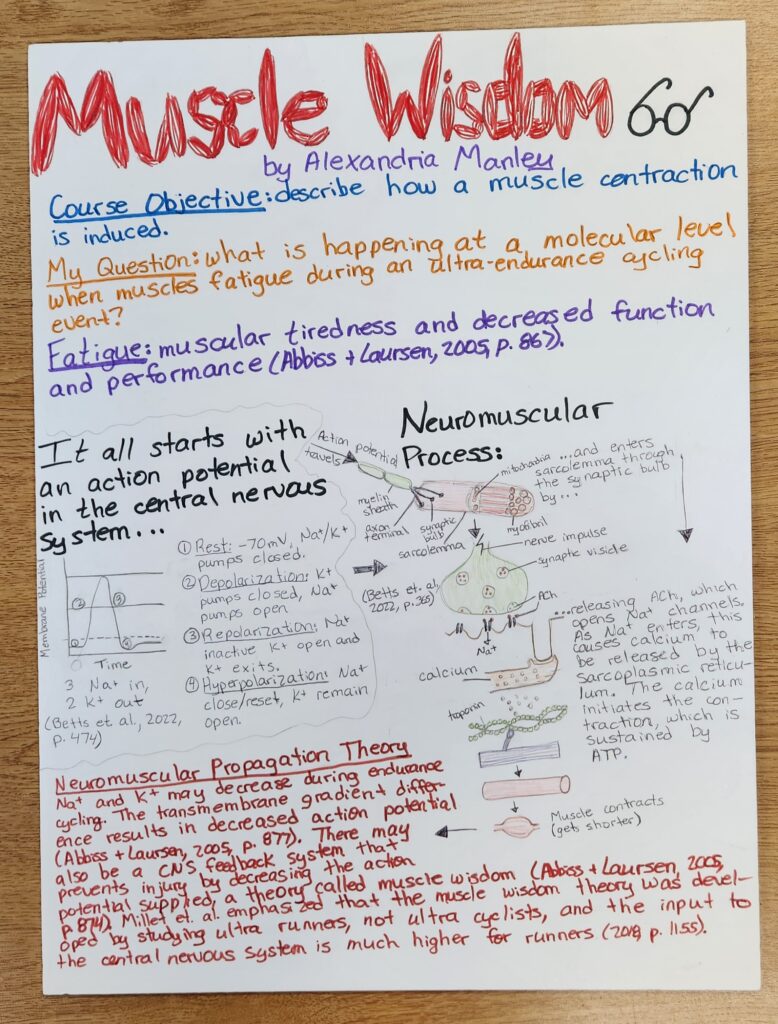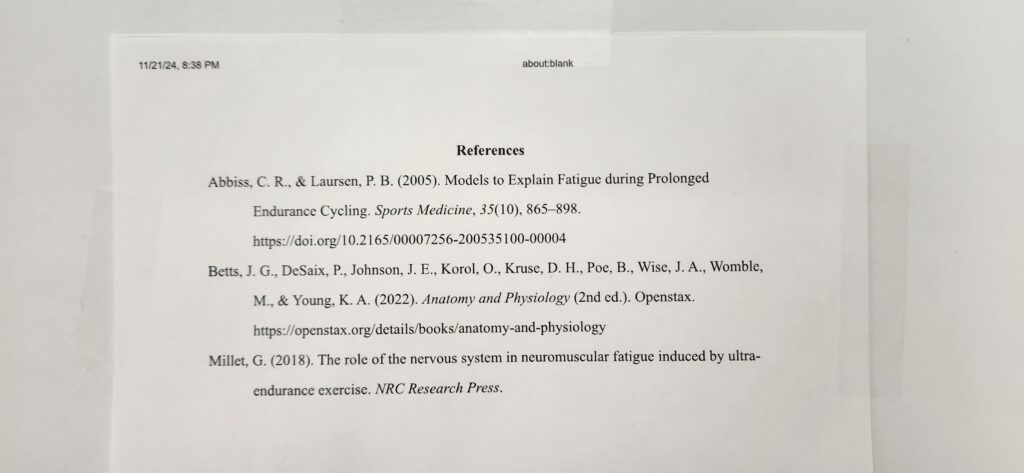

According to Abbiss and Laursen’s article, there are several different models to explain how and why muscles fatigue during ultra endurance cycling events and, within those models, there are submodels. The overarching models include the cardiovascular/anaerobic model, energy supply and energy depletion, neuromuscular fatigue (which is what I focused on), muscle trauma, biomechanical, thermoregulatory, and psychological/motivational (Abbiss & Laursen, 2005, p. 865). I focused specifically on the neuromuscular propagation failure theory and how this relates to the concept of muscle wisdom.
A muscle contraction begins with an action potential. At rest, the membrane is at -70mV and the Na+/K+ pumps are closed. When an action potential from the central nervous system is introduced, depolarization happens, causing Na+ pumps to open. The action potential travels down the neuron to the end of a synaptic bulb, which is part of the neuromuscular junction. Acetylcholine is released by the synapse, which is what opens Na+ pumps. When the pumps open, Na+ rushes into the cell, depolarizing it. The introduction of Na+ causes calcium to be released. Calcium initiates the muscle contraction and adenosine triphosphate sustains the contraction. Repolarization occurs when Na+ pumps become inactive and K+ pumps open to allow K+ to exit (Betts et. al., 2022, p. 474).
Na+ and K+ may decrease during endurance cycling, resulting in a transmembrane gradient difference and decreased action potential. This action potential difference results in the perceived feeling of tiredness. In this situation the muscle is less excitable and can be observed in lab EMGs (Abbiss & Laursen, 2005, p. 877).
There may also be a CNS feedback system that prevents injury by decreasing the action potential supplied. This means that the feeling of tired muscles is more than them actually being tired, but the body’s self-regulatory effort to prevent injury, strain, or even death. This concept is called muscle wisdom, and is the inspiration for my title. However, Millet et. al. emphasized that this theory was developed by studying ultra runners, not ultra cyclists. Muscle wisdom relies on strong inputs to the central nervous system. The theory is that high impact activities, such as running, expedite the feeling of fatigue because they provide strong input to the spine (or CNS). Because cycling is low impact, this system may not impact people who are cycling. Lastly, this theory is a “why” explanation for the subjective feeling of fatigue, and it is impossible to know with complete certainty that this is a reason people feel fatigued (2018, p. 1155).
In order to provide adequate context for the neuromuscular propagation failure theory, I drew the action potential graph and anatomy/physiology of a muscle contraction. This directly lines up with the course objective of “describe how a muscle contraction is induced.” In drawing and labeling the muscle contraction process, I gained a better understanding of the process. My project idea is more literal than some of the examples provided, but this more literal interpretation helped me gain a better understanding of a subject I felt I did not understand well.
References
Abiss, C. R., & Laursen, P. B. (2005). Models to Explain Fatigue During Prolonged Endurance Cycling. Sports Medicine, 35(10), 865-898. https://doi.org/
Betts, J. G., DeSix, P., Johnson. J. E., Korol, O., Kruse, D. H., Poe, B., Wise, J.A., Womble, M., & Young, K. A. (2022). Anatomy and Physiology (2nd ed.). Openstax.
Millet, G. (2018). The role of the nervous system in neuromuscular fatigue induced by ultra-endurance exercise. NRC Research Press.
